|
Africa
2024 Journal Pages:
1
2
3
4
5
6
7
8
9
10
11
12
January 12
Dombo Pools is a wetlands area on the northeast side of
Moremi Game Reserve in the Okavango Delta.
Natalie, Paula and I had passed through the area on
previous trips with Gee and stopped for lunch at the Hippo Pools
lagoon, but we had never camped or gone game driving there. We
were eager to explore this lovely area of wetlands, large lagoons
and wide floodplains. It is a haven for waterfowl and birds of all
descriptions.
We were out driving by 6:10. It was cloudy, and looked like
more rain. We skirted a floodplain and went by a flooded area with
many large dead trees sticking up eerily out of the water. We
could see a large eagle nest high in a tree. Several woolly-necked
storks flew over the plain, and we passed a flock of yellow-billed
storks.
Gee drove down a sand road through the forest, heading
toward Xakanaxa, near Paradise Pools, an area where we had camped
on a previous trip. A small herd of zebras moved quietly through
the trees, including two very young foals. It felt like we were in
an enchanted forest. The zebras’ white stripes seemed to glow
gently in the dim light, and they seemed like creatures from a
dream.
The sand road was very wet from all the rain, and our land
cruiser plowed through huge puddles with a loud swooshing sound,
the water lapping the floorboards. We followed the winding track
for miles, seeing many birds and the occasional antelope. Suddenly
I saw something in the road ahead, and called out, “Lion at
twelve o'clock!”
The huge male lion was stretched out in the middle of the
road. He had a thick dark mane and a taut, sinewy body. It was
obvious that he owned this space; he was not about to give way for
anyone who might want to pass. After all, why should he? He was
the undisputed king of the forest.
The lion turned his head and met our eyes; his gaze held us
spellbound. He couldn’t have been more than twenty feet from us;
we could see the many battle scars on his face and sides. Then he
sat up, raised his head, and let out a loud and lengthy roar.
His mighty call started with
several short low moans, followed by a prolonged series of long,
escalating roars, and ending with a series of about twenty short
whuffing growls. He put his whole body into it, his taut muscles
straining and his sides heaving with each resonating note. His
voice was challenging yet at the same time mournful - and very
loud.
A lion’s roar is a deep primal
sound that reverberates through your soul. Nobody could watch and
listen to the lion roaring close up and remain unmoved. With the
amazing acoustics provided by nature, the sound of each roaring
note actually echoed, as if he were deep in a vault. I could feel
the sound waves vibrate inside my chest.
‘Oh
my god, my father,’ I thought.
After several minutes our lion called again; this time he
was answered by another male lion in the distance. They traded
calls periodically, with the second lion moving closer with each
roar. Gee told us that the sound of the lions can be heard up to
five miles away. I couldn’t believe I was actually getting the
chance to experience it so close up; it had been the main thing on
my wish list for this trip. Lions
call to mark their territory, and also to locate other members of
their pride. I have
always felt that ‘roar’ is not quite the right description; it
doesn’t really sound like the familiar roar of the lion on the
old MGM movie
credits; it is a more lonesome or mournful sound, sort of a deep
throaty moan.
After a long while and half a dozen protracted roars, our
lion stood up, had a drink in a large puddle, and then walked down
the road. Soon he was met by the other male lion, who had just
arrived on the scene. Both had very full bellies; it was obvious
they had made a kill and eaten recently.
Gee said they were from the Dombo Pools Pride, also known
as Somahundu Pride. We watched them for about 45 minutes, then
left them in peace and continued on toward Xakanaxa.
There were large black millipedes all over the wet road,
and I saw a lizard in a tree as we drove by, but we were well past
it before I had a chance to call out for Gee to stop for it. After
a while we paused to watch a hamerkop wading in a puddle in the
road. These distinctive brown birds are fairly large, with a
sturdy bill and a hammer-shaped head. They are very unique, and
there is something I find quite appealing about them. The
hamerkops will make huge nests in a tree, using not only sticks
and branches, but also such things as strings, old clothes, shoes,
shreds of tire, litter, or anything else they can find.
|
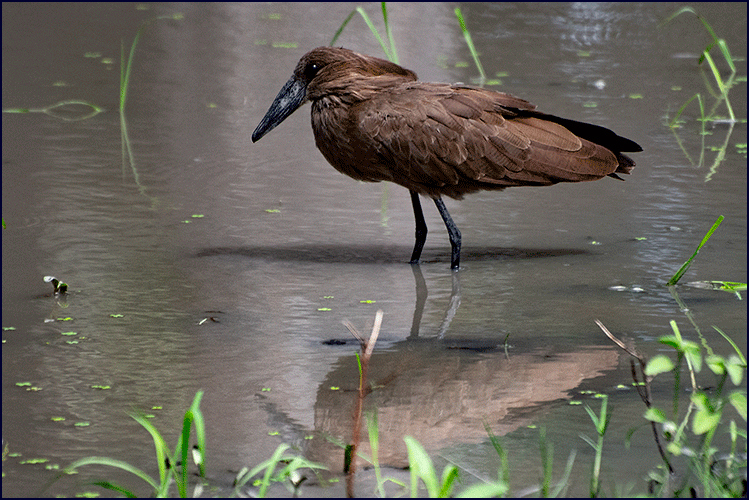
Hamerkop
|
We came to an area of especially beautiful forest with many
large trees and little underbrush. Many of the trees had long
horizontal limbs, just the sort you might expect a leopard to be
sleeping on. There were quite a few fallen trees that had been
knocked down by the elephants; they looked like good cross-country
jumps. I imagined galloping through these glades on a horse,
jumping the downed trees.
Soon we came out to a series of large lagoons in the midst
of this enchanted forest. Some of the pools had many dead trees
standing in the water; shifts in the earth’s tectonic plates
had caused the Okavango waters to change course and flood
areas that had formerly been dry land. These drowned forests had
an eerie beauty. We had reached Paradise Pools. It was a magical
place. We felt like we had been travelling all day to get here,
but it was actually only 9.45 a.m.
|
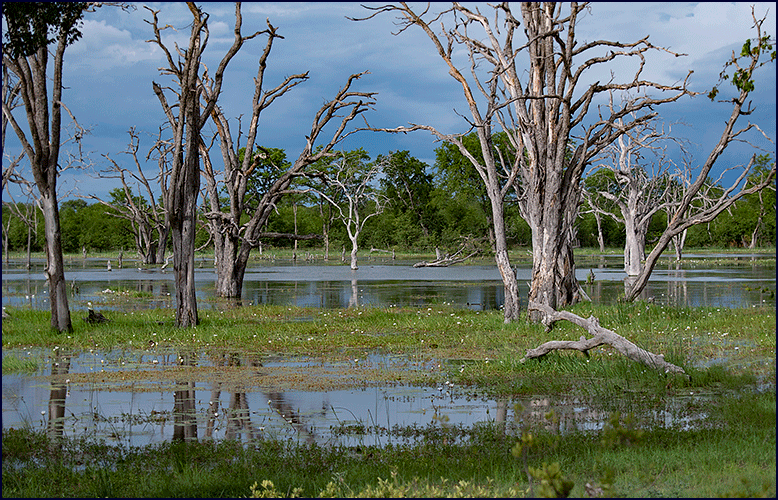
Paradise Pools
|
As we came out to a more open area, Gee heard the alarm
calls of several birds, and then of an impala. This is often the
best way to find predators; the birds, antelopes and monkeys will
raise the alarm when they see a lion, leopard or hyena, warning
each other of the danger. Sure enough, Gee followed these sounds
and soon found a mother leopard and her half grown cub, lying in
some dense brush under the trees. He said the youngster was
probably about six months old.
I think leopards are the most beautiful of the big cats.
These two were spectacular. Leopards are very solitary animals;
they usually live and hunt alone, except when a mother is raising
her cubs. They are smaller than a lion, but they are efficient
hunters, and can actually pose a greater threat to people walking
alone in the bush. Leopards are elusive and hard to find, so we
felt very lucky to get to spend some time with these two.
As always, we were impressed by Gee’s ability to listen
to alarm calls and read tracks, and find us the most elusive of
animals. Without his expertise we would not have seen a quarter as
much, nor learned so much about the habits and personalities of
the animals we did find. Self-drivers who rent a vehicle and go on
safari without a guide would be missing the majority of what we
were seeing with Gee.
The leopards were lazily eating the remains of a lechwe; I
was surprised they kept their dinner on the ground instead of
taking it up in a tree. We watched as they yawned and stretched,
licked themselves and each other, and walked around a little to
find the most comfortable spot. The youngster dragged a lechwe leg
away to chew on. After a while they lay down together and the
mother gave her cub a good grooming.
They looked a little restless; Gee said they probably
wanted some privacy for sleeping, so we left them to their nap.
Leopards
at Paradise Pools. Magical.
We left the leopards and drove around the area. A herd of
impala grazed in a glade among many huge trees; it was another
scene straight from the enchanted forest. A family of warthogs
foraged in the underbrush. We were able to get very close to a
lechwe buck and admire his massive spiraled horns, then we watched
as some of the younger members of his herd ran through the shallow
water. We found another pair of saddle-billed storks. A pair of
hadeda ibis perched on a tree branch; they are named for their Ha
De Da call.
|
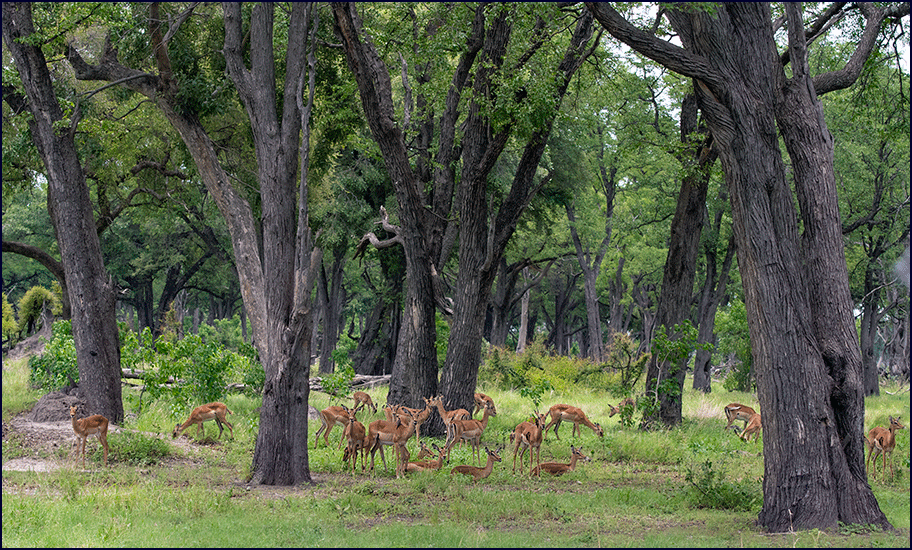
Impala in the
Enchanted Forest, near Paradise Pools
|
A
troop of vervet monkeys wandered through the grass, graceful and
lithe. The adults walked sedately, while the babies scampered with
carefree abandon, climbing trees and swinging on vines. The male
monkeys have bright powder blue balls, which always seems very
unexpected.
We swung back by the leopards to see if there was any
action; they has moved a bit deeper into the bushes, and were
still enjoying naptime. We bid them goodbye and moved on. As we
drove across a small stream Paula looked back and saw a quick
flash of motion; she was pretty sure it had been a honey badger,
but nobody else saw it.
We stopped for lunch at Jesse’s
Pools, a large open lagoon. A pod of hippos lounged out in the
middle, and several crocodiles floated near them.
A lot of the Delta waterfowl were there; we watched
white-faced ducks, yellow-billed storks, little egrets, Squacco
herons, and the lovely pinkish white roseate spoonbills. A goliath
heron, the largest heron in the world, waded regally in the
shallows searching for fish.
We sat in the camp chairs and ate an excellent lunch that
Mosa had prepared for us, and then relaxed and enjoyed the lovely
setting. Dragonflies hovered around us, and a butterfly landed on
Janell’s hand – surely that is a sign of good luck; Gee said
it as a common diadem.
Heading on toward Xakanaxa, we came across a huge male
lion, sound asleep in a small patch of shade under a tree. Gee
said he was from the Xakanaxa Pride. Without moving his head the
lion sleepily opened one eye and gave us a
hard look, then finding us of little consequence he closed
his eyes again and returned to his nap. Apparently adult male
lions do not feel any vulnerability when sleeping alone on the
African bush.
We met a car coming from the other direction and stopped to
greet them; it was a European couple, self-drivers without a
guide. ‘Did you see
anything?’ they asked us, ‘All we have seen is elephants.’
Coincidentally, elephants were about the only animal we hadn’t seen so far that morning. Gee gave them directions to the
lion we had just left sleeping in the shade, but afterward
told us he only gave them about a 10% chance of finding
him. No chance at all they would have found the leopards! This
became a bit of a reoccurring joke with us; ‘No way the
self-drivers would have found this
. . .”
We headed back through the enchanted forest on the same
road we had come in on. A family of kudus grazed under the mopane
trees; there were half a dozen adult females, one young male with
small horns just budding, and one small baby. We had been seeing
quite a few female kudus, but I was still waiting to see one of
the big males.
We watched some particularly active impalas; several
half-grown youngsters were racing back and forth in circles,
jumping high over imaginary obstacles. Several mothers stood in
the shade with half a dozen small fawns; evidently it was an
impala daycare center.
A dwarf mongoose stood on a log by the road; she was small,
with a dark brown coat. As we watched, three small heads popped
out of a hole in the log – her half-grown babies were taking a
good look at us. We got a quick glimpse of a common duiker, a
small antelope just slightly larger than the steenboks; they are
very elusive and rare. A
little further on a pair of steenboks stood close to the road,
less shy than most.
|
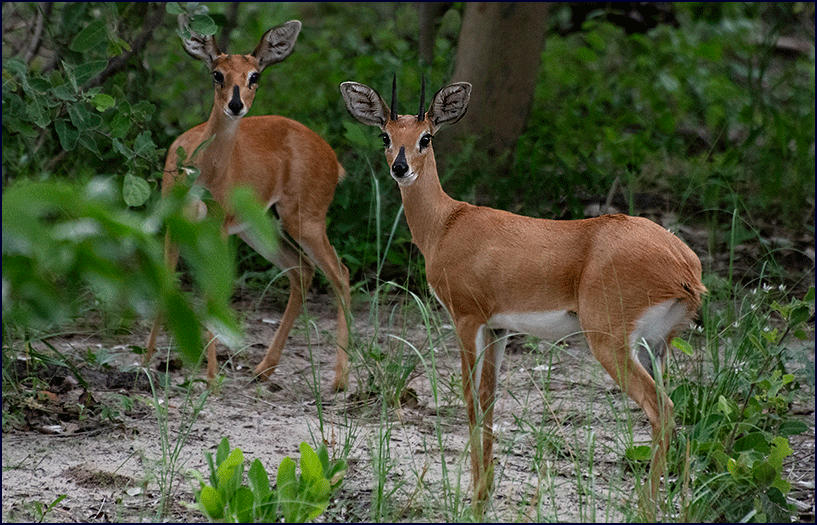
Steenboks |
Looking across the water we could see two large birds of
prey perched in a tall dead treetop, but could not quite make out
what they were. Gee drove around to the other side of the lagoon
where we could get a closer look; there were two juvenile fish
eagles. They launched themselves off the branch and flew away as
we approached.
We came across a pair of huge black birds with red heads
and wattles walking through the bush; they were southern ground
hornbills. They are very interesting birds, though somewhat
vulture-like in appearance. Gee told us they are very rare. They
can live up to 58 years, but the mothers only nest and raise
babies every four years. They lay two eggs, but often the first
baby to hatch will eat the other one.
|
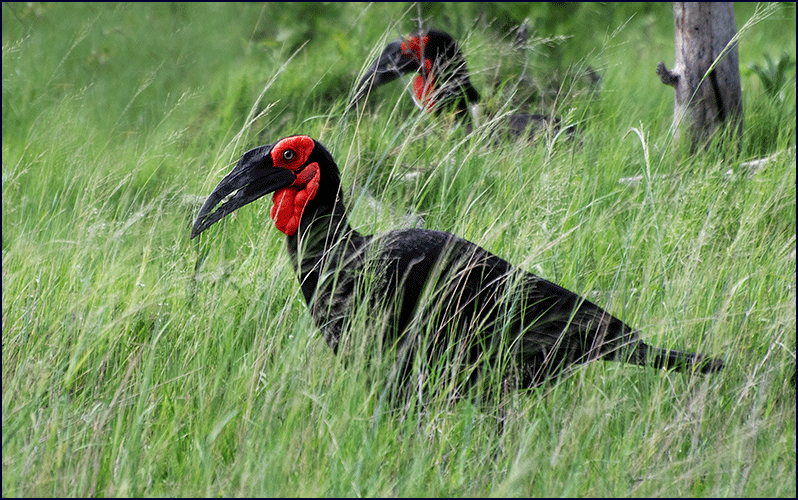
Ground hornbills
|
There were dream zebras in the clearing near camp. We
watched a very small foal nursing from his mother; his darker
stripes were still covered in fuzzy brownish baby fur.
We came across a bateleur eagle in a tree, right outside
camp, standing like a sentinel. These attractive birds are black
with brown and white on their wings, red faces and legs, and a
short tail. It was great to get to look at one of these
charismatic birds from close quarters.
|
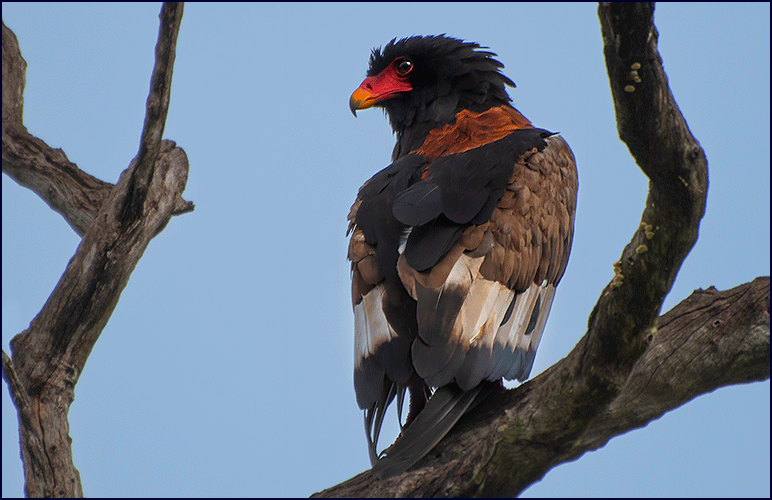
Bateleur
|
There were lechwes at the water hole in front of camp.
Again it was gently raining, so we sat around the table under the
dining tent instead of by the fire. We reviewed our favorite
sightings of the day; for me it was the roaring lions, though the
leopards were a close second. I made up a safari-based murder
mystery for the others to solve; it turns out the self-drivers did
it!
|
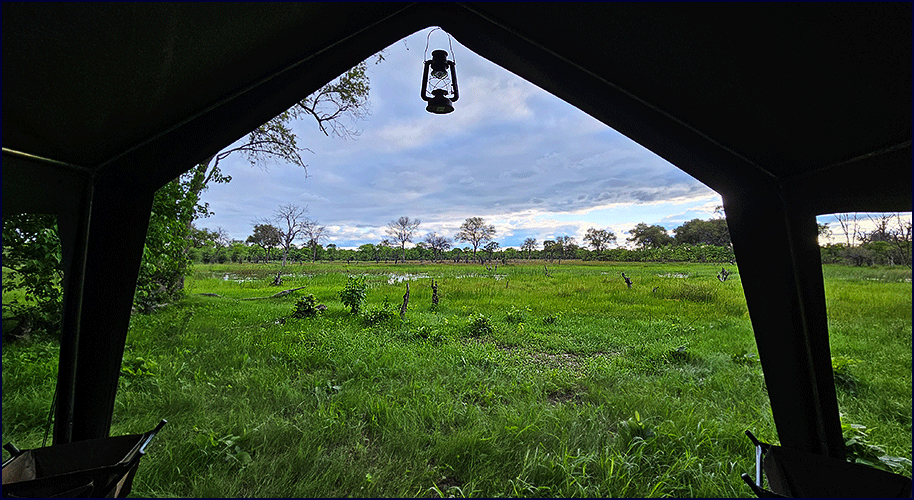
The view from our tent
|
This camp was a little more spread out along the edge of
the floodplain, and the tent I shared with Janell was the furthest
one, so Gee escorted us to our tent after dinner. After all, we
heard a leopard calling when we first arrived at this camp. I
went to sleep dreaming of leopards.
~
Continued
on next page ~
Africa
2024 Pages:
1
2
3
4
5
6
7
8
9
10
11
12
Back
to the AFRICA 2024 INDEX Page
|